Canaletto (Giovanni Antonio Canal)
Canaletto learned the basic principles of painting by executing large theatrical sets, a trade that he learned from his father Bernardo Canal. In 1719 he and his father travelled to Rome where Canaletto encountered the work of Giovanni Paolo Panini who specialised in classical ruins and panoramic urban views. The work of Luca Carlevarijs and Marco Ricci also played an important role in the development of Canaletto’s style. On his return to Venice in 1720 he registered in the painters’ guild and appears in their records until 1767. Canaletto’s first known views of Venice date to the 1720s and were commissions from Stefano Conti and the Prince of Liechtenstein. Canaletto’s friendship with the British consul, Joseph Smith, also began at this period. Smith was his principal client and responsible for promoting his work in England. Between 1740 and 1741 the artist travelled along the Brenta canal, producing numerous drawings and paintings. In 1746 he left for England where he remained until 1756, although making a number of short trips abroad. During his time in England, Canaletto depicted views of the countryside and of London. In 1760 he was again in Venice, where he resumed his activities although his creative powers were by now in decline. In 1763 the artist was made a member of the Academy of Painting and Sculpture. In addition to his work as a painter, Canaletto was also a draughtsman and printmaker, producing various series of etchings including one for Consul Smith entitled Vedute altre prese dai luoghi altre ideate. Much of Canaletto’s oeuvre was painted for foreign collectors who acquired his works as souvenirs while on the Grand Tour.










